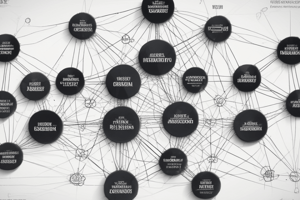Podcast
Questions and Answers
Organizational structure refers to the way an organization is configured into work groups and the reporting and authority relationships that connect individuals and groups together.
Organizational structure refers to the way an organization is configured into work groups and the reporting and authority relationships that connect individuals and groups together.
True (A)
Contingency theory is the main framework for understanding organizational design.
Contingency theory is the main framework for understanding organizational design.
True (A)
Specialization refers to the extent to which there are different specialist roles and how they are distributed within the organization.
Specialization refers to the extent to which there are different specialist roles and how they are distributed within the organization.
True (A)
Centralization refers to the extent to which authority to make decisions lies with the top of the organization.
Centralization refers to the extent to which authority to make decisions lies with the top of the organization.
Network organizations can expand rapidly and produce synergistic results, as each organization leverages its unique competence.
Network organizations can expand rapidly and produce synergistic results, as each organization leverages its unique competence.
Actor-Network Theory (ANT) recognizes that actors build networks involving only human actors.
Actor-Network Theory (ANT) recognizes that actors build networks involving only human actors.
Virtual organizations rely solely on conventional organizational boundaries to link people, assets, and ideas.
Virtual organizations rely solely on conventional organizational boundaries to link people, assets, and ideas.
Structuration theory emphasizes the importance of how actors understand the organization, but not the social context shaping their behavior.
Structuration theory emphasizes the importance of how actors understand the organization, but not the social context shaping their behavior.
Decentralization and organizational structure are not important concepts in management studies.
Decentralization and organizational structure are not important concepts in management studies.
Weber's ideal organizational structure includes specialization and division of labor, a hierarchical arrangement of positions, a system of impersonal rules, and personal relationships.
Weber's ideal organizational structure includes specialization and division of labor, a hierarchical arrangement of positions, a system of impersonal rules, and personal relationships.
Flat structures reduce the number of staff while retaining the same number of levels.
Flat structures reduce the number of staff while retaining the same number of levels.
Multidivisional structures are built around inputs and allow for faster responses to market conditions.
Multidivisional structures are built around inputs and allow for faster responses to market conditions.
Matrix organization design involves overlaying a hierarchical structure with a horizontal one around big projects.
Matrix organization design involves overlaying a hierarchical structure with a horizontal one around big projects.
Advantages of matrix structures include connecting specialized knowledge to all projects, increased flexibility to form cross-functional teams, facilitating mechanisms for dealing with multiple sources of power, and building project loyalties.
Advantages of matrix structures include connecting specialized knowledge to all projects, increased flexibility to form cross-functional teams, facilitating mechanisms for dealing with multiple sources of power, and building project loyalties.
New organizational forms, such as project organizations, operate primarily through project teams with functional departments having a supporting role.
New organizational forms, such as project organizations, operate primarily through project teams with functional departments having a supporting role.
Project organizations have characteristics similar to Mintzberg's 'Adhocracy,' which is a loose, organic network with few formal rules and regulations.
Project organizations have characteristics similar to Mintzberg's 'Adhocracy,' which is a loose, organic network with few formal rules and regulations.
True or false: Mintzberg's organizational forms include bureaucratic, organic, and matrix forms.
True or false: Mintzberg's organizational forms include bureaucratic, organic, and matrix forms.
True or false: According to Mintzberg, the machine form of organization has low formalization and standardization.
True or false: According to Mintzberg, the machine form of organization has low formalization and standardization.
True or false: Mintzberg's forces for proficiency, concentration, and innovation include encouraging standardization and formalization.
True or false: Mintzberg's forces for proficiency, concentration, and innovation include encouraging standardization and formalization.
True or false: Mintzberg's seven forces driving organizations include direction, efficiency, proficiency, and cooperation.
True or false: Mintzberg's seven forces driving organizations include direction, efficiency, proficiency, and cooperation.
True or false: According to Mintzberg, size is positively correlated to overall role specialization and formalization of procedures in an organization.
True or false: According to Mintzberg, size is positively correlated to overall role specialization and formalization of procedures in an organization.
Actor-Network Theory (ANT) and Institutional Theory both emphasize stability and resistance to change in organizational arrangements.
Actor-Network Theory (ANT) and Institutional Theory both emphasize stability and resistance to change in organizational arrangements.
Isomorphism refers to organizations in the same sector adopting similar structures due to conformity, mimesis, and risk aversion.
Isomorphism refers to organizations in the same sector adopting similar structures due to conformity, mimesis, and risk aversion.
Ineffective organizational structures can lead to high motivation, effective decision making, and low conflict.
Ineffective organizational structures can lead to high motivation, effective decision making, and low conflict.
According to Chandler's Strategy-Structure thesis, structure follows strategy due to economic efficiency.
According to Chandler's Strategy-Structure thesis, structure follows strategy due to economic efficiency.
Flashcards are hidden until you start studying
Study Notes
- Actor-Network Theory (ANT) explains the process of creating and maintaining networks for projects, focusing on rationales and concerns.
- Interessement: occurrence leads to behavior aligned with desired outcomes by enrolling actors.
- Mobilization: successful enrolment creates a network working towards solutions.
- ANT and Institutional Theory share focus on organizing people, technology, and knowledge.
- Institutional Theory highlights cultural influences on decisions and stability of organizational arrangements, but not change.
- Isomorphism: organizations in the same sector adopt similar structures due to conformity, mimesis, and risk aversion.
- Institutional Theory emphasizes stability, but environmental triggers and technology use impact structure.
- Ineffective organizational structures can result in low motivation, inadequate decision making, conflict, and rising costs.
- Strategy and structure are linked as organizations change strategies in response to the environment and technology.
- Institutional Theory's strategy-structure relationship is complex, as strategy influences structure more than vice versa.
- Chandler's Strategy-Structure thesis: structure follows strategy due to economic efficiency, but Amburgey and Dacin show a more complex relationship.
Studying That Suits You
Use AI to generate personalized quizzes and flashcards to suit your learning preferences.




